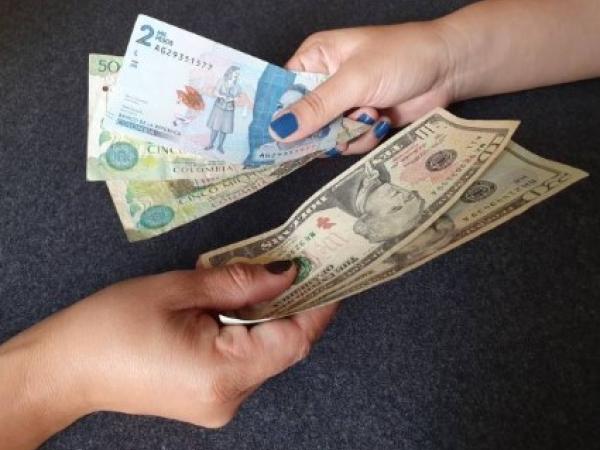The price of the dollar in Colombia has once again been the main topic on the local economic agenda in recent days, after, as had already been projected by various analysis centers, it shot above $4,100, driven this time by more factors. external than internal, which must be reviewed carefully to confront them and prevent them from climbing above what is desired again.
The first thing to say on this topic is that the North American currency closed last week at $4,150, close to its maximum in seven months and accumulating a depreciation of 7% in June, one of the highest among emerging countries. This depreciation allowed the Colombian peso to leave the range of $3,740 – $3,990 observed in the first five months of the year and will tighten investors’ accounts.
Dollar and Colombian peso
iStock
Although the wide interest rate differential between Colombia and the US, the reduction of the current account deficit, the seasonal inflow of foreign currency and favorable external conditions; They helped at the time to the stability that was seen for a long time; This streak seems to have ended and new circumstances are causing the dollar to rise to the levels already mentioned.
(For reading: Improvement in the economy, under observation: what is missing to confirm its recovery?).
Of course, it is worth remembering that this Monday, June 24, the currency lost almost 40 pesos and ended at a trading price of 4,104.59 pesos.
An announced depreciation
In its weekly analysis, the Corficolombiana Economic Research team focused on the variations of this currency and reviewing the causes of the movements that have been felt in the local market, highlighting first that it was something that had been noticed for a long time, so the instability that could surprise investors.

The price of the dollar continues to depreciate against the Colombian peso this week.
Portfolio File
“We consider that the recent depreciation of the exchange rate is incorporating both external and local risks that for several months were capturing the rates of public debt securities (TES) and the country risk premium,” these experts indicated in their report.
(You may be interested in: Ministerial scramble: Government would announce changes in the cabinet in the next few hours)
They also pointed out that the low volatility of recent weeks was thanks to four important factors, in addition to the difference in rates between the United States and Colombia, among which the reduction of the current account deficit driven by the fall in imports also stood out. , given the weakness of domestic demand and the seasonal inflow of foreign currency for the payment of taxes and the flows generated by Nutresa’s takeover bids.

Dollar and Colombian peso.
iStock
He also maintained that this was thanks to the favorable external conditions that occurred due to the soft landing of the global economy and high prices of raw materials, in the midst of the geopolitical conflict in the Middle East. Subsequently, they make it clear that although this helped a lot, many of this aid has already run out and it is time for everything to begin to adjust to the levels that were initially projected.
(Read here: This is the person who would replace Camacho in the Ministry of Mines and Energy)
“The behavior of the Colombian peso in the first five months of 2024 contrasted with the performance of both the public debt market and the country risk premium. The above was reflected in the divorce between the price of the dollar in Colombia and the 5-year CDS, which have been incorporating local idiosyncratic risks associated with the deterioration of the fiscal situation. There was a high correlation between the risk premium and the exchange rate (0.9), but it dropped during the first half to 0.3,” they explained.

Claudia Sheinbaum, elected president of Mexico
EFE
According to Corfi experts, a first factor that influenced the rupture of this panorama at the beginning of June were the results of the elections in Mexico, since the victory of the ruling party in the presidential elections with Claudia Sheinbaum (Morena Party) and The qualified majority in the legislative branch of the government coalition generated expectations that the most structural reforms would be approved. in Congress and generated fears about additional pressure on that country’s fiscal accounts.
(Also read: What is the status of cryptocurrency regulation in Colombia)
“Thus, the markets reacted through an increase in the risk premium and a strong depreciation of the Mexican peso. It is worth noting that this currency and the Brazilian real have an important weight in the portfolios of foreign investors in the region1, so the local electoral reaction ended up infecting other Latin American currencies, especially the Colombian peso,” they highlighted.

Economic growth
iStock
On the other hand, they recalled that the euro weakened against the dollar following parliamentary elections in Europe “which revealed signs of a return of nationalism” and the European Central Bank’s first interest rate cut in five years. Highlighting that “these events boosted the global strength of the dollar, measured through the DXY2, in a context in which the Federal Reserve (Fed) maintains its high rate stance for longer.”
(More news: In the 2023-2024 legislature, only 3.7% of the projects became laws)
Finally, when explaining the reasons for this depreciation, he maintains that another key external factor in the recent depreciation of the Colombian peso was the fall in international oil prices after the OPEC+ announcement in early June to begin reducing oil cuts. production starting in September of this year.

Economic growth
PHOTO: iStock
“The above led to a decrease in the price of Brent oil which, as of last Friday, was 4.2% below April levels. Although the depreciation of the Colombian peso during June was initially driven by external factors, it is important to note that there are idiosyncratic elements that exacerbated subsequently the trend, making it deeper than in other currencies in the region,” says the report.
(Other news: The 1,000 largest companies in the year of the slowdown)
Despite these pressures from abroad, Corfi highlighted as positive the fact that the Government had shown signs of responsibility with the adjustments to the Medium Term Fiscal Framework, since the markets were nervous about the magnitude of the lack of government income. this year, and its ability to cut its spending enough, and in the end what was expected in the markets was done.

Colombian pesos
iStock
In this sense, they closed by pointing out that if the behavior of the exchange rate had been aligned with that of the 5-year CDS, the dollar would have oscillated between $3,900 and $4,400 during the first semester. However, they consider that the exchange rate has additional room for depreciation, especially in the third quarter and given this, they project that during the second semester it will register an average of $4,250, which will imply a depreciation of 8% compared to what was observed in the first semester.
(You may be interested in: Expectation for the Court’s decision on a lawsuit for the closure of two Glencore mines)
“On an internal level, this will reflect our fiscal vulnerabilities and the lower seasonal flow of foreign currency associated with the payment of Ecopetrol dividends and with the payment of corporate income tax by large taxpayers,” they concluded.













Add Comment